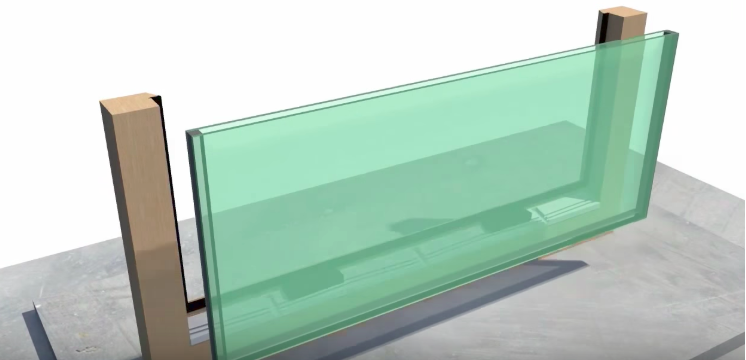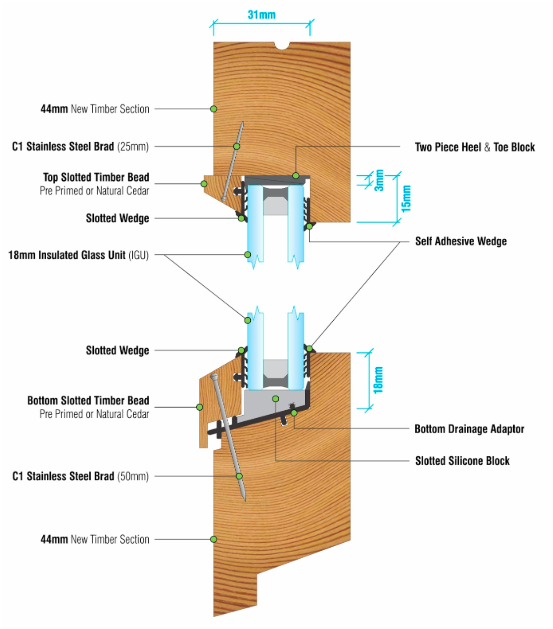For keeping heat in during the winter and unwanted heat out in the summer, pretty much the biggest step you can take is to double glaze your windows. Are you wondering exactly how do double glazed windows work?
How can they insulate your home in both the cold and the heat? How much of an impact will double glazing really have on your home?
Double Glazing: What It Is
When your windows are double glazed, your existing single pane of glass is removed and replaced by an insulating glass unit, also called an IGU. Your IGU consists of two panes of glass and a sealed air space in between.

The double glazing unit can be customised to suit the unique needs of every area of your home:
- Special types of glass can be used for one or both pieces, such as acoustic grade glass for enhanced acoustic performance or low-e glass for better summer insulation.
- The air space in between can be filled with an inert gas, such as argon, which slows down the movement of thermal energy, thus increasing the insulation power of your IGU.
- Glass thickness and the size of the air space also impact the performance of the double glazing.
Double Glazing: How It Works
For a more energy-efficient, comfortable home, you need double glazing. How does it work and why is it such a critical element for keeping your home insulated?
The double glazing protects your home against heat loss, and in the summer, overheating. How double glazed windows work has a lot to do with the properties of glass.
Glass absorbs thermal energy but it doesn’t hold onto it. It will always radiate the heat energy it absorbs. When it comes to your windows, your glass is basically channelling warmth to where you don’t want it to go. Your indoor heating is escaping through your windows in the winter. In the summer, it’s pouring in.
This is why windows are responsible for a lot of your home’s heat loss. A single pane of glass can lose as much as 10 times the heat of the same area of insulated wall.
In the summer, the heat goes in the other direction. Your glass absorbs the sun’s thermal energy and will then heat your home up, making it harder to keep your house cool and forcing you to rely more on your air conditioner. Even with window dressings, the heat is still radiating in. Curtains and blinds may stop visible light, but that isn’t the problem. Thermal energy is.
When your windows are double glazed, you can actually open your curtains and let all that gorgeous sunlight stream in because your windows are insulated from the heat.
With double glazing, the movement of thermal energy is slowed down because of the air space between the double glazing. The heat energy from the piece of glass that’s exposed to the heat gets trapped. The heat is also blocked by the second pane of glass. Some types of glass will even reflect the heat energy back where it came from, making your double glazing even more effective.
This is how double glazing works to insulate your home all year round. The insulation also helps to block out noise pollution, making your home more energy-efficient and peaceful.
The Problem with How Double Glazing Works for Wooden Windows
This window system is almost perfect. But, double glazing has a fatal flaw with wooden windows: moisture.
What can happen is, small amounts of water – mostly from water vapour in the air that forms condensation on glass and moisture ingress from the external weather – can end up pooling around the square rebate around the double glazing.
For timber joinery, any amount of water sitting in the glazing rebate can be disastrous. It can cause the seal on your double glazing to fail.
The moisture begins to rot, and eventually, mould and mildew growth. Your double glazing also won’t insulate as well because air and heat energy are able to pass through once the seal fails.
Instead of waiting for the inevitable and letting your double glazed wooden windows fail in a few years from moisture, the window professionals at Thermawood created a revolutionary solution – the Patented Thermawood Dry Retrofit Double Glazing system.

Here’s how it works
The timber windows are retrofitted instead of ripping out the joinery and replacing the entire window. This way, you can maintain the aesthetic and charm of your timber windows. This is also a more efficient, cost-effective process.
Then, we use our patented draining system, which is created with special tooling. We make a 15-degree slope underneath the double glazing to encourage any moisture to run down.
Every 100 millimetres there is a draining slot so the water drains out underneath the window bead.
This prevents moisture, rot and mould from ever forming and protects the double glazing from failing. Which means, your home will benefit from all the advantages of double glazed windows, without ever putting your timber windows at risk.
It’s a process designed to maximise the longevity of double glazing in wooden windows. With it, windows can last for a century, not just a few years.

[Free Guide]
The Most Comprehensive Guide
Available to You Anywhere

![How Do Double Glazed Windows Work? [Learn from the Pros]](https://www.thermawood.co.nz/wp-content/uploads/2020/03/how-do-double-glazed-windows-work-3.png)